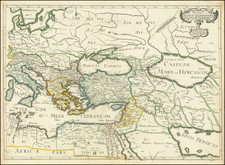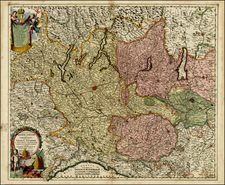A finely engraved allegorical scene depicting the Republic of Venice at War, by the eminant cartographer Vincenzo Maria Coronelli.
This attractive compostion features the figure of the Dogressa (the wife of the the Dogge, or elected head of state of Venice), who also personifies Athena (the Goddess of War), being armed by her maidens. The Venetian Lion prances confidently in the foreground. The panoramic tableau in the background shows an epic battle scene where the Venetians are taking a walled port city from the forces of one of their antagonists, perhaps the Ottoman Turks. During the time that this print was made, Venice controlled a large maritime empire, that not only included the Veneto in Italy, but extended down the coast of the Adriatic to include Istria, Dalmatia, and then parts of Greece.
Vincenzo Maria Coronelli (1650-1718) was one of the leading cartographers and globe-makers of the Baroque era. Born in Venice, he apprenticed as a xylographer, before joining the Franciscan order in 1665. Around 1678, after studying Astronomy, Coronelli began working as a geographer and was commissioned to make a set of Terrestrial and Celestial Globes for Ranuccio II Farnese, the Duke of Parma, which were 5 feet in diameter. Coronelli was next invited to Rome to construct a similar pair of Globes for Louis XIV. From 1681 to 1683, Coronelli lived in Paris, where he constructed a pair of 10 foot diameter globes for the King that weighed 4000 pounds. These spectacualr globes are today on display at the Bibliotheque nationale de France (Paris).
Coronelli then returned to Venice where he published his great atlas, the Atlante Veneto (1698) and founded the Accademia Cosmografica degli Argonauti, the world's first geographical society.
Vincenzo Maria Coronelli (1650-1718) was one of the most influential Italian mapmakers and was known especially for his globes and atlases. The son of a tailor, Vincenzo was apprenticed to a xylographer (a wood block engraver) at a young age. At fifteen he became a novice in a Franciscan monastery. At sixteen he published his first book, the first of 140 publications he would write in his lifetime. The order recognized his intellectual ability and saw him educated in Venice and Rome. He earned a doctorate in theology, but also studied astronomy. By the late 1670s, he was working on geography and was commissioned to create a set of globes for the Duke of Parma. These globes were five feet in diameter. The Parma globes led to Coronelli being named theologian to the Duke and receiving a bigger commission, this one from Louis XIV of France. Coronelli moved to Paris for two years to construct the King’s huge globes, which are 12.5 feet in diameter and weigh 2 tons.
The globes for the French King led to a craze for Coronelli’s work and he traveled Europe making globes for the ultra-elite. By 1705, he had returned to Venice. There, he founded the first geographical society, the Accademia Cosmografica degli Argonauti and was named Cosmographer of the Republic of Venice. He died in 1718.









![Mappa Maris Mediterranei Fluxus currentes et Naturam Motionum explicans [Map of the flow and motion of the Mediterranean Sea explaining its currents and nature.]](https://storage.googleapis.com/raremaps/img/small/90931.jpg)
![[ Italy ] Italiae Novissima Descriptio Auctore Jacobo Cataldo Pedemontano](https://storage.googleapis.com/raremaps/img/small/100527.jpg)
![[Heightened with Gold Leaf! -- Paul's Travels ] De Reysen Christi Des Heyland en Pauli met andere syne Bloedgetuygen](https://storage.googleapis.com/raremaps/img/small/72900.jpg)

![[ Sicily / Sardinia ] Septima Europe Tabula](https://storage.googleapis.com/raremaps/img/small/101893.jpg)
